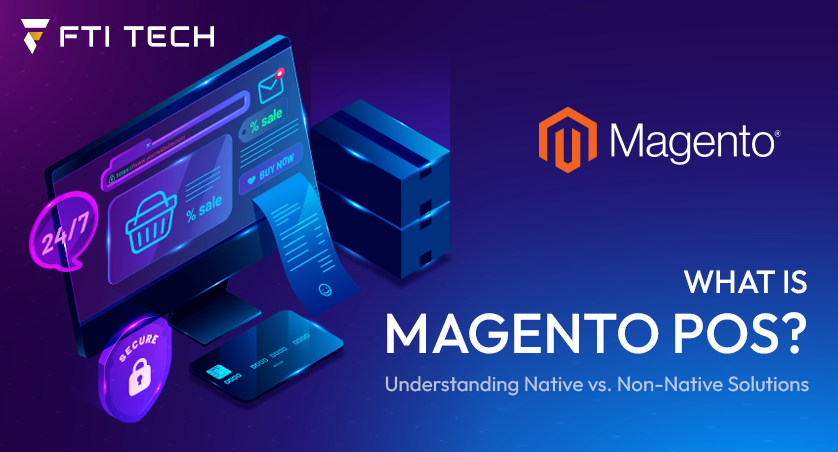What is Magento POS? Understanding Native vs. Non-Native Solutions
Omnichannel strategies, where online meets offline, are on the rise in the retail sector. If you’re running an eCommerce store or managing retail operations, you’ve likely felt the growing need to unify your online and in-store operations. That’s where a Magento POS (Point of Sale) system comes in.
A Magento POS allows you to synchronize inventory, manage real-time transactions, and track customer purchases across both physical and digital storefronts. From monitoring your best-selling items to maintaining accurate stock levels, it brings everything under one roof. No wonder more small businesses are leaning into POS systems — in fact, studies show that 95% of small retailers processing under one million transactions annually, rely on them.
Two major types of Magento POS solutions are available: Native and Non-Native. Each has its strengths, and choosing the right one depends on your business structure, tech stack, and long-term goals.
In this guide, we’ll break down how Magento POS systems work, compare native vs. non-native options, and help you determine the right fit for your operations.
What is a POS System?
Point-of-Sale (POS) system is a setup that allows businesses to process transactions where the customer pays for a product & services. It streamlines the checkout process, maintains the inventory in real time, issues receipts, and in most cases even collects customer information for future marketing or support.
In the past, businesses relied on cash registers and manual logs to record each sale — which worked but didn’t scale well or offer much visibility. Today’s POS systems are a major upgrade. They help retailers scale operations and also provide deep insights into customer behavior, like which products sell the most or when foot traffic peaks.
POS systems have also evolved moving from on-premise setups to the cloud. The cloud-based solutions offer faster processing, remote access, multi-store syncing, and automatic updates. These modern systems meet the needs of growing retailers who want to integrate physical and digital storefronts.
That is why for merchants who are operating their online store using Magento, the selection of the POS system is very important. This way they can aim to streamline in-store operations alongside eCommerce sales.
Retailers looking to bridge the gap between physical and digital commerce can find helpful solutions at FTITech.
What is Magento POS?
Magento POS (Point of Sale) system is a solution which links your Magento-powered online shop with your physical retail operation. It allows merchants to manage sales, inventory, and customer data in real time providing seamless experience to the customers and employees.
For example, you are operating a fashion brand that runs a website and retail stores. With Magento POS if a customer purchases something in-store then your inventory gets automatically updated on your website. Similarly, customer profiles, order history, and loyalty points stay in sync — regardless of where it was bought.
Magento POS enables:
- Updates on inventory levels in real time
- Synchronization of customer profiles and purchase history
- Order management and analytics capabilities
- Auto application of promotions and discounts.
Features of Magento POS Systems
- Multi-store support– Manage all your stores from a single dashboard or interface.
- Barcode scanning – Speeds up checkouts and reduces manual entry errors.
- Offline Mode – Keep operations running even without an internet connection.
- Loyalty programs – Facilitates customer retention through integrated loyalty systems.
When you are planning to implement Magento POS, looking for aspects like compatibility is very important. Magento POS solutions, in general, can be compatible with Magento Open Source and Adobe Commerce, but each platform has its different capabilities.
| Feature | Magento Open Source | Adobe Commerce |
| Cost | Free | Paid (Enterprise-level) |
| Ideal For | Small to mid-size businesses | Large or B2B enterprises |
| Customization | High (via extensions) | Built-in features, advanced scalability |
| B2B Features | Limited | Comprehensive (quoting, company accounts, etc.) |
| Flexibility | Depends on third-party tools | Offers native enterprise tools |
What Are the Types of Magento POS Systems?
There are two major types of Magento POS systems for eCommerce stores: One is the native, and the other is the non-native. Native POS systems integrate directly with Magento, allowing smooth data syncing, and advanced functionality, whereas non-native systems need connectors, middleware, or APIs for their integration. Let’s see the difference between the two:
Native Magento POS
Native POS systems are tightly integrated with Magento, which means better data syncing and fewer issues during updates. These are built specifically for Magento and usually come in the form of tailored extensions or apps.
They are designed to offer real-time inventory sync, customer data updates, and smooth order processing across your sales channels.
Some well-known native Magento POS systems include:
- Magestore POS is a popular option that is preferred by the retailers who want to sync their online and offline sales in real-time without having to depend on third-party connectors.
- Aheadworks POS is an extension of Magento that provides store owners with more control over how the POS functions within the Magento setup.
- Webkul POS works well for businesses managing multiple stores. It helps with inventory control and customer data tracking, and it all runs inside Magento without needing external tools.
Non-Native (Third-Party) POS
Non-native POS systems are not made for Magento specifically. Hence, they must be connected using APIs, plugins, or middleware. These systems are standalone and may require extra steps during setup. But they can also support multiple platforms, which is useful if you’re selling on more than just Magento.
Some examples of non-native Magento POS systems:
- Vend is a cloud-based POS system with features for sales reporting, inventory management, and loyalty programs. It does not come with integrated Magento. So, you need to use middleware for integrations.
- Square is another non-native POS system that does not offer Magento integration by default. You have to use extensions or the API to integrate Magento. However, it does offer features for sales cycle analysis and inventory tracking.
How Does a Magento POS Work?
Magento POS combines hardware and software components to enable transactions. Some of the major components of this system are,
- Hardware– Bar code scanners, receipt printers, and a physical POS machine that reads cards.
- Software– A software product helps track inventories, stock levels, and customer preferences.
A Magento POS system connects your retail store activity with your Magento website — so everything from product scans to inventory updates happens in sync. Here’s how it works:
- The customer selects a product.
- A cashier scans the item using a barcode scanner.
- The POS system calculates the total, including taxes or discounts.
- The customer pays — using cash, card, QR, or digital wallet.
- A receipt is printed or sent via SMS/email.
Now comes the Magento part:
- The system updates product inventory in real-time on your Magento store.
- Order details are pushed to the Magento admin dashboard, just like an online sale.
- Customer data is updated, keeping loyalty points and purchase history in sync.
If the internet drops, Magento POS continues working in offline mode. All orders are stored locally and sync automatically once the connection is restored, so your operations never pause.
Quick Tip:To avoid issues like double entries or mismatched inventory, make sure your system is configured for clean sync and data integrity between store and server.
Native vs. Non-Native Magento POS: Key Differences
When deciding between a native and non-native Magento POS, it’s important to look beyond just pricing or features. The choice affects your integration depth, maintenance workflow, and long-term scalability — especially if Magento is your core platform.
Here’s a quick comparison:
| Feature | Native Magento POS | Non-Native POS |
| Built for Magento | Yes | No |
| Integration | Seamless | API-based or via middleware |
| Cost | Higher upfront | Varies based on provider and custom work |
| Support & Maintenance | Magento-specific teams and updates | Depends on third-party support |
| Customization | Deep, Magento-level customization | Limited to Magento-specific connectors |
| Ideal for | Magento-exclusive retailers | Multi-platform businesses (e.g., Magento + Shopify) |
When Should You Choose Native Magento POS?
If your retail operation is built fully on Magento and you want tight control over store data, real-time sync, and backend visibility — native solutions are built for that. You get out-of-the-box compatibility with Magento’s features like catalog rules, customer groups, and tax settings.
Example: A fashion retail chain running Magento across all stores can benefit from native POS like Magestore to centralize inventory and streamline both online and offline checkouts without middleware hassles.
When Does a Non-Native POS Make Sense?
If you’re managing multiple sales channels across different platforms (like Magento + Shopify or marketplaces), a non-native POS gives you more flexibility. These tools are designed to sync with multiple systems, though they might require more integration effort and could have fewer Magento-specific features.
Example: A business selling via Magento and WooCommerce might use Vend or Square as a non-native POS, connecting them via APIs or extensions.
Whether you’re leaning toward a native or non-native POS, it’s worth discussing your setup with experts. Explore Magento development services at FTITech to see how we support tailored integrations.
How to Choose the Right Magento POS for Your Business?
Choosing the right Magento POS system depends largely on your business model and operational requirements. If you’re also planning a digital upgrade or launching a new store, following a clear website development process helps bring everything together smoothly.
For instance, if you are running several physical stores and a Magento online store then you will need a POS system to integrate online and offline transactions. If your store is large and the customer’s database is huge, scalability and performance should be your top consideration. Before deciding, ask yourself:
- Is your current POS outdated or limiting growth?
- Can it handle an increasing volume of transactions and customer data?
- Is it compatible with your Magento version and extensions?
- Does it comply with regulations?
While all of these considerations are important, here is a checklist you can use,
- Check for the real-time sync feature between offline and online payments
- Evaluate Magento POS capability to handle multi-store transactions
- Choose cloud-based POS for scalability, but evaluate if a local setup is more suitable
- Ensure the POS system provides support for mobile-based receipts and has PWA support.
- Check if the POS system offers data security and compliance with regulations like PCI DSS.
Conclusion
The right Magento POS can unify your online and offline sales, but the choice between native and non-native comes down to your business model. Focus on long-term scalability, integration depth, and how well the system fits your tech stack — not just the features. Choose what grows with you. Contact us to get personalized guidance on the best Magento POS setup for your business.



